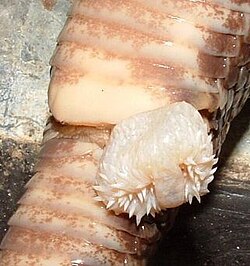Lock-and-key mechanism
The lock-and-key mechanism or hypothesis is the idea that genital morphology has evolved to maintain reproductive isolation between species, by ensuring that mating can only occur between a male and female of the same species. The idea was first postulated in 1844 by French entomologist, Leon Dufour, who observed the diversity of genital morphology among Dipteran flies. [12] It is thought that the physiological differences between species prevents hybridization. The genital lock-and-key mechanism can operate in two ways: by the direct prevention of copulation and insemination due to physical incompatibilities, or by a sensory lock-and-key that induce behavioral responses that disrupt mating attempts. [13] [14] This mechanism is found across the animal kingdom, from Lepidoptera to Squamata.
In snakes and lizards, morphological differences in the reproductive organs are believed to exist to help the male copulate with the female. Spikes and hooks are thought to assist the male in fixing the hemipenis in place during mating, and are made specifically compatible to the female of the species. For example, species with branched hemipenes have females with branched cloacas, and species with many spikes have females with thicker cloacal walls, compared to those of species with males having little or no spines. This huge variety among the reproductive organs of Squamata is of interest to taxonomists, as it may be able to shed light on evolutionary relationships among reptiles. [11]
Sexual conflict theory
The function of the ornamentation of the hemipenes is still being explored by researchers, but one study supports the theory that the spines that can be found on many hemipenes is a trait to assist in longer, and hence more successful, reproduction for males. Through surgically removing the large basal spine of the red-sided garter snake, researchers found that while males were still able to mate, the duration of mating and the depth of copulation were much shorter than the unaffected control males, indicating that the spines play a crucial role in the male's ability to mate successfully with the female. [15] Females responded to the male hemipenis with strong vaginal contractions that prevented longer mating. To test that the purpose of the contractions was to shorten mating time, researchers anesthetized the female to prevent the contractions and found that mating did indeed last longer.
Cryptic female choice
Often times, female snakes and lizards also have the ability to control whether they get pregnant immediately after mating or not, to account for the fact that the ideal time for mating may not translate to the most optimal time for ovulation and gestation. Consequently, females can store sperm internally [16] for as long as five years, or possibly longer. [17] This phenomenon is known as cryptic female choice, as the physiological mechanisms making this possible are hidden within the body, and the female has the ability to influence when egg fertilization occurs.
While the exact mechanism of how the female controls the stored sperm to fertilize her eggs remains unclear, it is believed that the specialized pockets found in the reproductive tract play a key role. [18] As a result, a female can mate with multiple males and choose when to fertilize her eggs. Furthermore, females can also produce offspring that can feature genetic material from multiple males in a single clutch if she mated with more than one male.
A product of this system is that males are not guaranteed to successfully reproduce and bear offspring from a single mating. Therefore, it is in their interest to mate with as many females as possible to increase their chance of passing on genetic material. This is one hypothesized reason for males having two penises instead of one: as each hemipenis is associated with one testis and only one side can be used during mating, having a second hemipenis functions as a "backup" and ensures that mating can continue even if one side were to run out of sperm.
It is important to distinguish between cryptic female choice and facultative parthenogenesis, a form of asexual reproduction. Due to the female's ability to get pregnant long after she has been in contact with a male, it is difficult to distinguish between the two in ambiguous cases. In such circumstances, molecular testing techniques can be used to identify whether her offspring share all or some of their genetic make-up with their mother.



